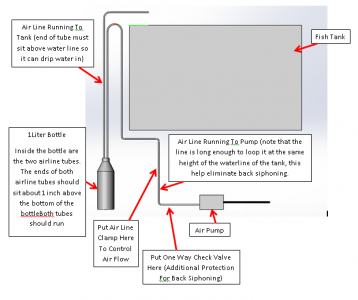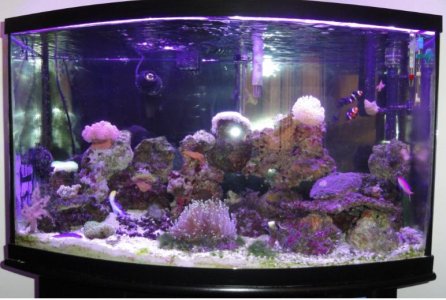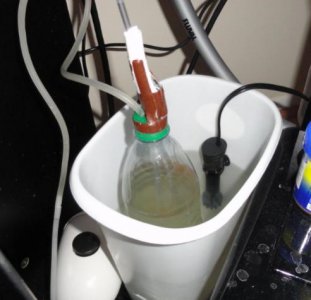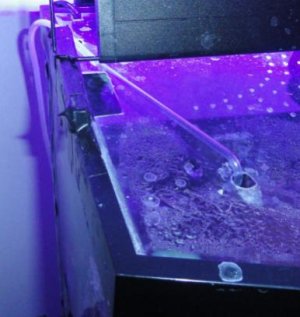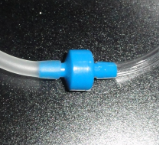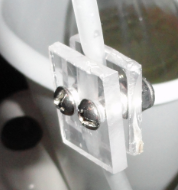ReefJunkie01
New member
Hi All,
So I've been trolling these forums for a while and never made an account. I have been in the salktwater tank keeping for about a year now and, thanks to the information posted on this forum, I have been able to keep a very healthy 46 gallon tank.
Just wanted to return the favor for what I had gained from the members of this site and post about what I've learnt in the care of purple queen anthias.
I have owned two (technically three, but the third was partially crushed during shipment to me so I got it just in time to watch it die.........) purple queens at this point.
I failed with the first one I owned, when I purcased the fish I did not know it was as difficult a fish as it was. The fish looked a little skinny, but the store owner had stated to me the fish would eat anything they threw at it, it was just that the fish had a high metabolism. Shame on me for not having the owner feed the fish in front of me before I purchased it. I took the fish home and, after 24 hours it came out and was swimming quite happily, but, it would not eat. I went through about 8 different types of food (arctic pods, oyster feast, different types of phyto, different crushed flake, crushed pellets, shaved PE Mysis, shaved blood worms, cyclopeeze, etc), built up quite a bit of food but the fish still would not readily eat. I had found the only way I was able to get the fish to eat was to wait for it to fall asleep, then shoot water soaked frozen food at it's face (it would suddenly wake up, eat like it was mad for about 5-10 seconds, then try to go back to sleep).
I began feeding it tisbe and tigger pods, and, it would readily eat this, however, the other fish in the tank would out-compete it, and, as I know now, it is a schooling fish and will run away unless it feels like it is in a school of fish. Also, as my mandarin ate all day, the mandarin would wipe out all the copepods through the day.
In desperation to get the fish more comfortable I bought another purple queen hoping it would be less stressed. The second purple queen was in really good shape and, while it appeared to have the same feeding habits as my first purple queen, the second one definitely did bring the first purple queen out. After about 24 hours of of introducing the second purple queen, they were pretty much inseparable and would swim around the tank. But, again, neither one would eat unless I fed tigger pods to the tank, and, it would have been impossible for me to feed tigger pods throughout the day while I was at work.
I set out to build an automatic feeder system for the tank, and, tried my hand at hatching baby brine shrimp. Turned out, this was the ticket.
The feeder system was pretty simple, a one liter bottle with two holes in the cap, and, through the two holes stick airline tubing (holes must be very tight to let no air out). Then, through the inside of the cap, attach two lengths of rigid airline tubing which are long enough so the ends of both sit about 1 inch from the bottom of the bottle (this allows you to constantly get swimming bbs as opposed to the dead ones at the bottom). Now, with the other side of the tubing (outside the bottle), run one line of tubing to the top of the tank where the opening of the tube can drip water into the tank (warning, DO NOT stick the tubing under the water line of the tank, it will back siphon into the air pump and cause a slow flood, the opening of the tubing must sit permanently abive the water line). With the other tubing, run it directly to the air pump, but, what I recommend is to put a one way check valve in place as well as make this tubing long enough so you can loop it up to the level ot the waterline of the tank, this further prevents back siphoning into the air pump. Then, get an automatic timer (I got a digital one from the home depot) and program the timer to turn the air pump on/off for at least 5 times throughout the day, every day (I have mine programmed for 10 feedings of the bbs throughout the day, 1 minute feedings each time at about 5 drops per second, which, based on my hatching, feeds about 180-200 bbs at each feeding).The final thing to do is to tune the system so it drips water into the tank when it is feeding (if you do it full blast, then you'll empty the 1 liter bottle in about 2-3 feedings). What I recommend doing is to get a mechanical adjustable clamp so you can clamp down on the airline tubing running to the air pump. What I did is too two pieces of lexan, drilled holes into both, then used two nuts and bolts to slowly compress the airline tubing. I would recommend to slowly adjust the nuts and bolts while the feeder system is on and feeding tank water from the 1 liter bottle until you see the feeder system feed at a rate of 5 drops per second, or at least at a rate where you can see separate drops fall into the tank).
Now, with using the feeder system, I learnt that pretty much the entire batch of brine shrimp will die within a 24 hour period with no aeration (as the PH drops to toixic levels). It is for this reason that the rigid tubing which feeds air into the bottle is at the bottom of the bottle, so when it feeds the shrimp, it gives just a little bit of air throughout the bay to keep the shrimp alive for the day). At night, whatyou also need to do is uncap the bottle so as to relieve all air pressure, and allow the pump to run all night long, which will elevate/keep the PH steady until the next day when the feeder system will be ready to be used. In the morning, just turn the pump back on timer mode, screw the bottle cap closed, and the unit will do it's thing throughout the day.
Unfortinately, by the time I had this unit up and running, my first purple queen had completely lost her desire to eat, and, instead of eating, it would just sleep all day trying to conserve energy. The drawback from all the sleeping though was that it would miss practically all the feedings. So, in the end, the first purple queen died about 4 days after I had the feeder system running.
As the second purple queen was newer however, and not gone past it's threshold of appetite loss, from the time I got the feeder system running, the second purple queen ate like it had not eaten in months. The feeding response is fun to watch, because, once it senses that the bbs is in the water, it goes ballistic and will dart around the tank eating everything it can. I have had the second purple queen for about a month now, and, it has been one of the most active and lively fish in the tank.
So, I took a detour here, and, what I've learnt with the purple queens are that they are kind of like a mandarin, once they get past the threshold of appetite loss, there is no turning back, the fish will be lost. The key is to get the fish from a suppler that had been actively feeding them live food, and continue feeding them live food. Do not expect to convert them to frozen foods at all, you need to expect that there is a possibility you will be feeding them live food for the rest of their lives. Don't expect to get lucky, because most likely all that'll happen is the fish will die and you'll have lost your money.
As of two days ago, my purple queen has just started taking small bites here and there of some shaved PE Mysis, but, it will only take a handful of bites per feeding and then just swim around in the food, interested in it, but still skeptical about it. I will continue to feed the system bbs permanently now as all the fish in the tank seem to love them.
Just wanted to share my experience with this difficult but worthwhile fish. Hopefully this helps with anyone trying to take on an endeavor like this.
So I've been trolling these forums for a while and never made an account. I have been in the salktwater tank keeping for about a year now and, thanks to the information posted on this forum, I have been able to keep a very healthy 46 gallon tank.
Just wanted to return the favor for what I had gained from the members of this site and post about what I've learnt in the care of purple queen anthias.
I have owned two (technically three, but the third was partially crushed during shipment to me so I got it just in time to watch it die.........) purple queens at this point.
I failed with the first one I owned, when I purcased the fish I did not know it was as difficult a fish as it was. The fish looked a little skinny, but the store owner had stated to me the fish would eat anything they threw at it, it was just that the fish had a high metabolism. Shame on me for not having the owner feed the fish in front of me before I purchased it. I took the fish home and, after 24 hours it came out and was swimming quite happily, but, it would not eat. I went through about 8 different types of food (arctic pods, oyster feast, different types of phyto, different crushed flake, crushed pellets, shaved PE Mysis, shaved blood worms, cyclopeeze, etc), built up quite a bit of food but the fish still would not readily eat. I had found the only way I was able to get the fish to eat was to wait for it to fall asleep, then shoot water soaked frozen food at it's face (it would suddenly wake up, eat like it was mad for about 5-10 seconds, then try to go back to sleep).
I began feeding it tisbe and tigger pods, and, it would readily eat this, however, the other fish in the tank would out-compete it, and, as I know now, it is a schooling fish and will run away unless it feels like it is in a school of fish. Also, as my mandarin ate all day, the mandarin would wipe out all the copepods through the day.
In desperation to get the fish more comfortable I bought another purple queen hoping it would be less stressed. The second purple queen was in really good shape and, while it appeared to have the same feeding habits as my first purple queen, the second one definitely did bring the first purple queen out. After about 24 hours of of introducing the second purple queen, they were pretty much inseparable and would swim around the tank. But, again, neither one would eat unless I fed tigger pods to the tank, and, it would have been impossible for me to feed tigger pods throughout the day while I was at work.
I set out to build an automatic feeder system for the tank, and, tried my hand at hatching baby brine shrimp. Turned out, this was the ticket.
The feeder system was pretty simple, a one liter bottle with two holes in the cap, and, through the two holes stick airline tubing (holes must be very tight to let no air out). Then, through the inside of the cap, attach two lengths of rigid airline tubing which are long enough so the ends of both sit about 1 inch from the bottom of the bottle (this allows you to constantly get swimming bbs as opposed to the dead ones at the bottom). Now, with the other side of the tubing (outside the bottle), run one line of tubing to the top of the tank where the opening of the tube can drip water into the tank (warning, DO NOT stick the tubing under the water line of the tank, it will back siphon into the air pump and cause a slow flood, the opening of the tubing must sit permanently abive the water line). With the other tubing, run it directly to the air pump, but, what I recommend is to put a one way check valve in place as well as make this tubing long enough so you can loop it up to the level ot the waterline of the tank, this further prevents back siphoning into the air pump. Then, get an automatic timer (I got a digital one from the home depot) and program the timer to turn the air pump on/off for at least 5 times throughout the day, every day (I have mine programmed for 10 feedings of the bbs throughout the day, 1 minute feedings each time at about 5 drops per second, which, based on my hatching, feeds about 180-200 bbs at each feeding).The final thing to do is to tune the system so it drips water into the tank when it is feeding (if you do it full blast, then you'll empty the 1 liter bottle in about 2-3 feedings). What I recommend doing is to get a mechanical adjustable clamp so you can clamp down on the airline tubing running to the air pump. What I did is too two pieces of lexan, drilled holes into both, then used two nuts and bolts to slowly compress the airline tubing. I would recommend to slowly adjust the nuts and bolts while the feeder system is on and feeding tank water from the 1 liter bottle until you see the feeder system feed at a rate of 5 drops per second, or at least at a rate where you can see separate drops fall into the tank).
Now, with using the feeder system, I learnt that pretty much the entire batch of brine shrimp will die within a 24 hour period with no aeration (as the PH drops to toixic levels). It is for this reason that the rigid tubing which feeds air into the bottle is at the bottom of the bottle, so when it feeds the shrimp, it gives just a little bit of air throughout the bay to keep the shrimp alive for the day). At night, whatyou also need to do is uncap the bottle so as to relieve all air pressure, and allow the pump to run all night long, which will elevate/keep the PH steady until the next day when the feeder system will be ready to be used. In the morning, just turn the pump back on timer mode, screw the bottle cap closed, and the unit will do it's thing throughout the day.
Unfortinately, by the time I had this unit up and running, my first purple queen had completely lost her desire to eat, and, instead of eating, it would just sleep all day trying to conserve energy. The drawback from all the sleeping though was that it would miss practically all the feedings. So, in the end, the first purple queen died about 4 days after I had the feeder system running.
As the second purple queen was newer however, and not gone past it's threshold of appetite loss, from the time I got the feeder system running, the second purple queen ate like it had not eaten in months. The feeding response is fun to watch, because, once it senses that the bbs is in the water, it goes ballistic and will dart around the tank eating everything it can. I have had the second purple queen for about a month now, and, it has been one of the most active and lively fish in the tank.
So, I took a detour here, and, what I've learnt with the purple queens are that they are kind of like a mandarin, once they get past the threshold of appetite loss, there is no turning back, the fish will be lost. The key is to get the fish from a suppler that had been actively feeding them live food, and continue feeding them live food. Do not expect to convert them to frozen foods at all, you need to expect that there is a possibility you will be feeding them live food for the rest of their lives. Don't expect to get lucky, because most likely all that'll happen is the fish will die and you'll have lost your money.
As of two days ago, my purple queen has just started taking small bites here and there of some shaved PE Mysis, but, it will only take a handful of bites per feeding and then just swim around in the food, interested in it, but still skeptical about it. I will continue to feed the system bbs permanently now as all the fish in the tank seem to love them.
Just wanted to share my experience with this difficult but worthwhile fish. Hopefully this helps with anyone trying to take on an endeavor like this.

